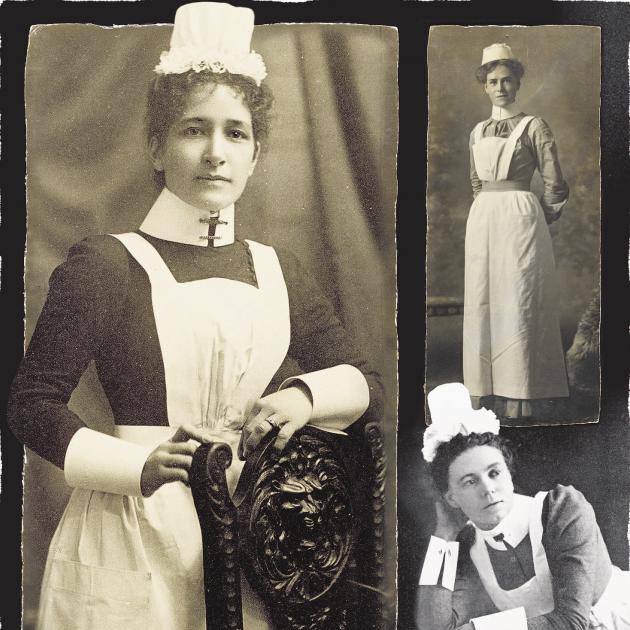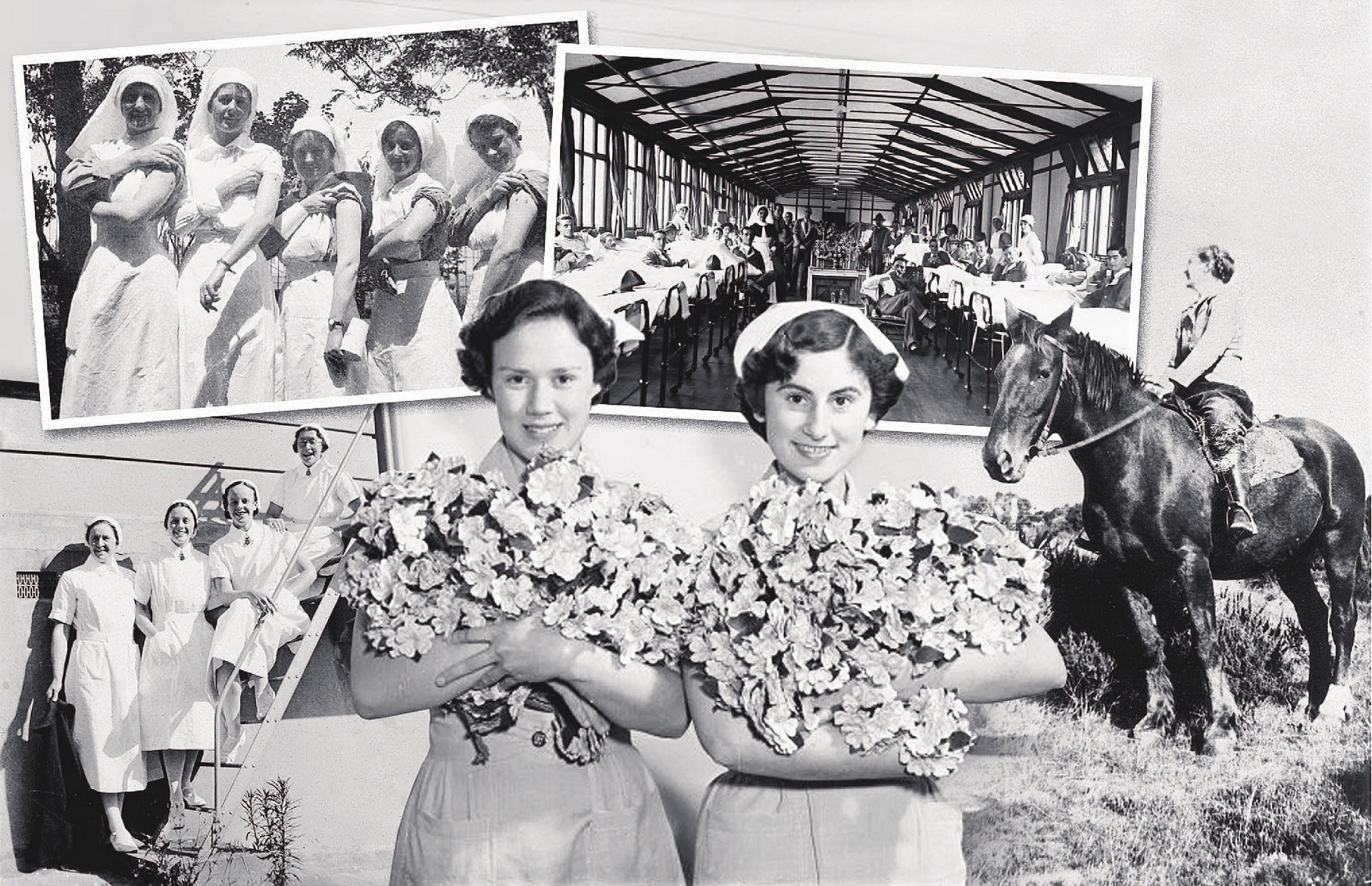
It is Christmas Eve, 1911, in Naseby, Central Otago.
A nurse, who has been given a large number of beautiful flowers to decorate her hospital ward, is walking down to the village to borrow some vases.
She passes the cottage of an old man, a veteran of the Crimean War, who has taken an interest in nurses since helping Florence Nightingale down the gangway when their ship docked at Scutari, Albania, half a century earlier.

He brings three posies of humble flowers from his wife’s garden and tells the nurse they are for decorating the hospital.
The nurse is in a quandary. She wonders what Nightingale, who died the previous year, would do.
On Christmas morning, the men in her ward wake to individual arrangements of the veteran’s flowers in small sand jars next to their beds. For the patients, precious memories are stirred, including a mother’s window garden in a distant homeland and flowers placed in a long-dead sweetheart’s hands.
No long-stemmed flowers in tall vases could have awakened such memories, the nurse observes with satisfaction.
"I love that connection," Pamela Wood, who has just told the story, says with a bright smile.
"A nurse at the southern edge of the Empire thinking about a nurse leader at the centre of that empire and what she would recommend."
The story also begs a fascinating question, Wood, a nurse, teacher and historian, says.
Modern nursing in New Zealand began in the 1880s as part of a diaspora of British nurses around the globe.
"So, did they bring a British nursing culture, or did a New Zealand nursing culture emerge? And what was that culture?"
Answering that question, Wood says, is the essence of her just-published book New Zealand Nurses: Caring for our people, 1880-1950.
Drawing on more than 30 years of research, teaching and practice, Wood has produced the first cultural history of nursing in New Zealand.
Spanning the first 70 years of the profession, her work explores the distinctives of nursing in this far-flung island nation, examines perceptions of nurses held by the public and by nurses themselves, and shines a light on the elements of New Zealand’s nursing culture.
"What were ... the values, the rites of passage and the symbols, its history and traditions, its gossip and folklores? What was that culture of nursing?"
Wood is visiting Dunedin, contemplating a return to the city she has already lived in four times, although not for the past two and a-half decades.
She began training as a nurse at Middlemore Hospital, Auckland, in 1966.
Her first job was as a staff sister at Dunedin Hospital, in the gynaecology ward.
"I had worked Christmas Day. And two people came around to give patients the Richmond shilling."
This was an annual gift to patients from the estate of former Dunedin publican James Richmond.
"I remember the surprise and delight on the patients’ faces.
"Dunedin values its history in the same way it values education."
Another Christmas, gynaecologist Prof Laurie Wright came on to the ward to carve the patients’ festive dinner turkey, Wood recalls with a laugh.
"I thought, ‘These poor women, they’ve just had operations and here he is flourishing a carving knife’."
In 1970, Wood became a "sister tutor", organising the teaching programme at Wellington Hospital.
She returned to Dunedin a few years later, working in the surgical ward at Wakari Hospital; was here again for almost a decade to the mid-1980s; and came back a fourth time in 1992 when Otago Polytechnic started a nursing degree.
In between, she worked elsewhere in New Zealand, and in Australia and the United Kingdom, in nursing, teaching, research and leadership roles. Wood also raised three sons.
The two decades to 2016 were spent teaching masters and PhD nursing students at Victoria University, Wellington, and in research leadership at Monash at Federation Universities in Australia.
After returning to New Zealand for family reasons, Wood "retired" in 2018 and immediately began working on her book.
"Rather than trying to cover everything about the history of New Zealand nursing, I was interested to focus on the culture.
"Once I decided that, everything else fell into place."
Nursing in New Zealand changed enormously during those first seven decades, but retained its core and its international linkages, Wood says.
"The striking thing for me, delving into this history again, was the sense of pride nurses had of being New Zealand nurses. And at the same time, being able to identify with an international profession.
"Those two things, they’re not in conflict, but there is a tension between the two."
The growth of the profession in Aotearoa produced many international firsts.
New Zealand was the first country to have a chief nurse: someone in a government department with a responsibility for nursing.
"Because of that, we had somebody ... who could pay attention to nursing and help it develop and get it recognised as an essential part of the health system."
This was the first country to have nurse inspectors of hospitals; the first to have specific nursing legislation, giving nurses a particular professional standing; and the first to have an enfranchised nursing workforce.
Nurse leaders overseas were very envious, Wood says.
"They ... said, ‘What you are doing there is quite remarkable, because you have a nurse in a government department and you have the vote, which gives you a prestige — people take note’."

New Zealand was also the first country to have a government scholarship scheme to support indigenous women to train as nurses.
There is a myth attached to this first, Wood says.
For 90 years, until the new millennium, the first Maori registered nurse was believed to be Akenehi Hei.
About 20 years ago, an earlier registration came to light.
But Wood’s research has revealed an even earlier date. It is now believed that Kate Wyllie, who trained at Gisborne Hospital and registered in 1902, has the honour of being the first Maori registered nurse.
Despite the factual error, the Hei myth has served an important role, Wood says.
"Akenehi Hei was a very astute person, well esteemed as a nurse. And, so, she has been a role model that other nurses have been able to follow."
Of course, not all nurses were models of service.
"It’s not to say there weren’t naughty nurses. I’ve got a chapter on that."
World War 1 gave New Zealand nurses their first chance to measure themselves against their sisters from other colonies and from the "homeland".
"Canadian nurses won the uniform. They had a very smart Navy uniform with brass buttons.
"But the ‘colonial nurses’ were seen as being hardworking and different.
"So, they were sought after. It gave New Zealand nurses and colleagues from the other Empire countries the sense they had something to offer.
"As one of the New Zealand nurses said, ‘Thank heavens for my colonial life’, because she could see it gave her that get-on-and-do attitude."
Nursing in New Zealand came in all shapes and sizes, from hospital and district nursing to back-block and Maori settlement nursing. As new services developed, nurses also took roles in clinics, schools and factories as well as in war and disaster zones.
"So, the range was tremendous — as it is today. I mean, nurses are everywhere."
Despite having three decades of knowledge to draw on, Wood spent three years on additional research and writing to produce the final draft of New Zealand Nurses.
An unexpected challenge was deciding when to stop researching.
"We have an abundance of historical material about nursing in New Zealand.
"My challenge was to decide, ‘OK, what is reasonable coverage of sources?’."
One unsolved puzzle was the first name of a British nurse who worked alongside Maori nurses in rural areas.
Her surname is McElligot. Searching through registers, documents and newspaper articles, including contacting the London hospital where Wood believes McElligot trained, has, however, failed to yield a first name.
"She was employed to work in the fever camps, which were mostly serving Maori patients who got typhoid fever, and also working in communities to help with sanitation.
"It would be nice to have included her first name."
Comparing nurses of today with nurses of the past has to be done carefully, Wood says.
Take, for example, the work of nurses during the 1918 influenza pandemic and during the Covid pandemic of the past two years.
During both pandemics, a century apart, nurses provided the best care they could in extremely difficult circumstances.
But there was one significant difference. And it produced quite different outcomes, she says.
"The difference is that nurses today are trying to do that [provide care] as well as protect their own families and community."
In 1918, and until the late-1960s, nurses had to be single, Wood explains. Single nurses lived together in nurses’ homes. If they married, they left nursing.
"They didn’t have the same responsibilities for family and households that they do today because they weren’t married."
As a result, during the influenza pandemic, 75% of nurses got sick and the health system became overwhelmed. Retired nurses were called up and the public was asked to volunteer.
"It was just a flood of patients coming in with influenza. And the hospitals could not cope."
The then minister of public health said, "They’re dropping like hay before the reaper’s scythe."
It was thought that 37 nurses died during the pandemic. Wood’s research lifts the toll to 42, not counting volunteers who also succumbed.
"So, the core of nursing is still the same: trying to help people, trying to care for people, trying to protect people.
"But it’s different now because of what nurses are having to do, trying to also protect their families."
The public has always seen nurses as "doing heroic things".
"Self-sacrificing. Devoted angels."

But nurses have never described themselves in those terms, Wood says.
"They have always identified as professionals. We’ve looked to be recognised and respected as professionals."
And while the idea of nurses as heroic and self-sacrificing speaks to the public’s perception of the valuable role they play, it hasn’t helped nurses gain recognition as professionals.
"It has got in the way, for example, of payment.
"New Zealand nurses have a 114-year record of being underpaid.
"It has recently significantly changed, which is great. But up until now it has always been underpaid."
What emerges from Wood’s research, and her book, is a nursing culture that recognises the value of its roots but freely adds distinct characteristics as it develops to meet the needs of the country and its people.
"I hope readers will understand the valuable part nurses have played in the health system of our country," Wood says with another smile.
"The enduring thing is that New Zealand nurses are adaptable and resourceful.
"Right from the beginning of it being recognised as a profession, right the way through to today, they’re still developing new services.
"I hope that will come alive for readers in the many stories that nurses have left us."
At the end of World War 2, Wood says, a senior nurse, Edith Lewis, who had served in both world wars, was asked to look after a ship-load of women liberated from the Japanese civilian internment camp in Hong Kong, Stanley Camp.
Lewis did this at the military hospital in Trentham, Christchurch.
"She was told they were suffering from malnutrition, and all the diseases that go with that. She knew, and her nurses knew, how to care for those women."
But they decided they needed to go beyond that; to show the traumatised women they were not only being cared for but also cared about.
"So, they filled the wards with flowers, and beautiful things they could find, and coloured cushions and books with beautiful pictures.
"And the women absolutely responded to that."
Most of the women they cared for were from Britain. After they had recovered, they were shipped home.
Lewis saw them off. When she got back to her quarters, she found they had left her a gift — a beautiful Royal Doulton figurine of an old woman selling balloons.
"She recognised it, because the women had shown it to her as a treasure they had managed to hide and safeguard through their internment.
"I just love that, because it shows what nursing is about. It’s not just the physical care of somebody. It’s understanding what’s going on for them as a person, or as people, and responding to that and supporting them in whatever way’s appropriate in that circumstance.
"I think New Zealand nurses are very good at that."













